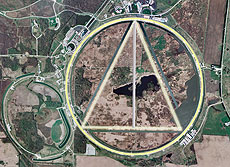HALLoWS to test MAGIC
 |
|
The new accelerator complex will experimentally test the theory MAGIC |
For years, scientists have relied on burdensome data analysis and expensive experiments to slowly pick away at each piece of our understanding of the universe. But a new theory might explain everything as a whole: Matter and Antimatter Guide for Ideal Conditions.
"MAGIC could be the answer to everything," said Chris Quigg, a Fermilab theoretical physicist. "Unlike the Standard Model, MAGIC is a complete theory with very few gaps. We'll need minimal experimental analysis to provide evidence."
The theory explains the origin of mass, the imbalance of matter and antimatter as well as the expansion of the universe. While MAGIC has support from numerous theorists, experimentalists are still skeptical.
"On paper, MAGIC is enchanting," said Debbie Harris of the Particle Physics Division. "But we don't want to accept a theory without testing. We need experimental verification."
Engineers have designed an accelerator that will do what some are calling impossible: prove MAGIC exists.
"We call it the High Acceleration Linear Lumos of W boson to Strange, or HALLoWS," said Roger Dixon, head of the Accelerator Division. "The design is based on an obscure paper by J.K. Rowling who first postulated this idea in the mid-1990s."
HALLoWS consists of three accelerators: a linear accelerator called ELDER, a trilateral accelerator called CLOAK and a cyclotron called stoNE.
"The interplay of particles as they pass between the three accelerators will either verify or reject MAGIC as a theory," said Harris. "This experiment could change how we think about physics and the universe."
But preliminary studies have yielded strange results that experimentalists are struggling to explain.
"As soon as particles enter the CLOAK prototype, they disappear. Particles in ELDER gain mass at an alarming rate. And particles in the stoNE prototype have a much longer half-life than predicted," Dixon said. "According to current theories, this is impossible, and we have not been able to figure out why we are observing these results."
But theorists think these preliminary results are perfectly in line with MAGIC and only strengthen MAGIC as an all-encompassing theory of everything.
"MAGIC tells us to expect the unexpected, do the impossible and follow our hearts," Quigg said. "You have to believe in it for it to work."
|